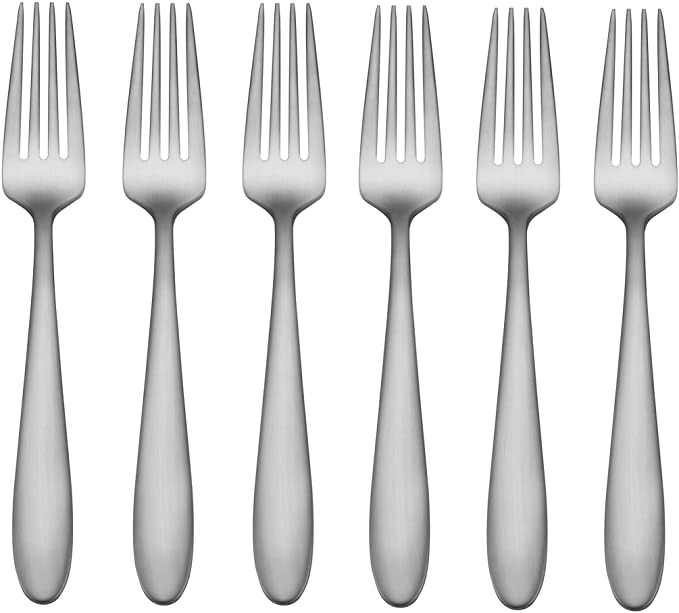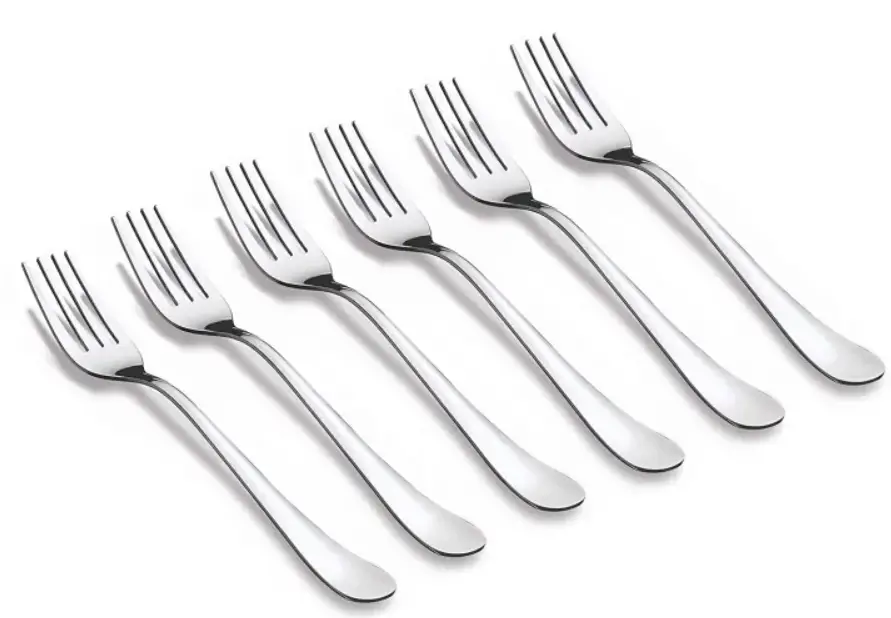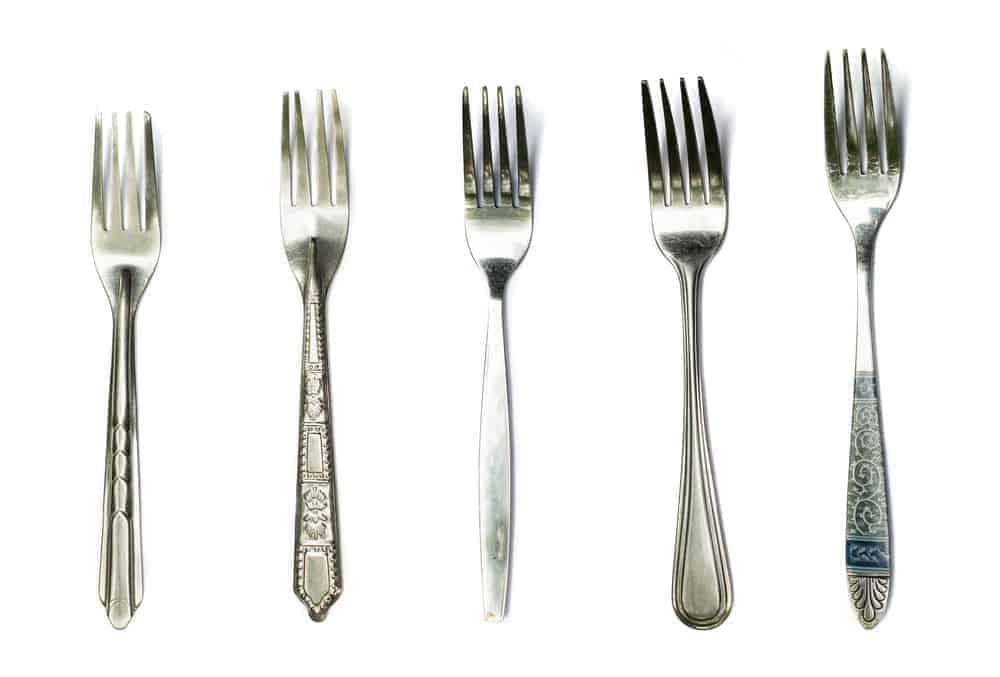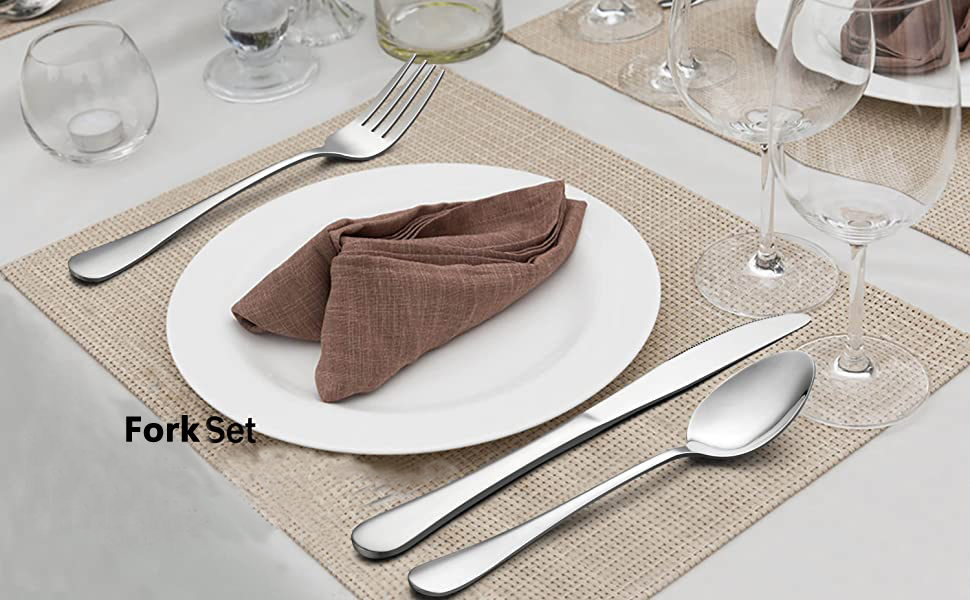Have you ever wondered why there are different types of forks? You may have noticed that when eating a salad you use one fork, then when it’s time for the main course, another type of fork appears.
Why is that and what’s the difference between them? Let us take an in-depth look at two common types of forks: the Salad Fork and the Dinner Fork. In this blog post, we will explore their unique qualities to help understand why they each play a special role on your table setting!
What is a Salad fork?

A salad fork is the smaller of the two forks and is typically used for salads, appetizers, and desserts. It usually has four tines (prongs) that are spaced farther apart than a dinner fork. The tines of a salad fork are shorter in length as well.
A salad fork is a type of silverware that is designed specifically for enjoying salads. It has four tines and a shorter handle than other types of forks, such as dinner forks. The longer tines make it easier to spear larger items in your salad. Salad forks are usually smaller than other types of forks, making them the perfect utensil for reaching into those hard-to-reach places on the plate and scooping up any last bits of deliciousness.
Salad forks can also be used for eating antipasti, fruit salads, or certain pasta dishes. They often come in sets with spoons and knives for a complete dining experience. Many people prefer to use salad forks when entertaining guests because they add an elegant touch to the table setting. They can be found in a variety of materials and styles, making them perfect for any occasion.
What is a Dinner Fork?

A dinner fork, which is also known as an entree or main course fork,has four longer tines that sit closer together when compared to a salad fork. This type of fork is generally used for most entrees such as pasta dishes, meat dishes, and fish dishes.
A dinner fork is one of the most common and recognizable types of forks. It has four tines and a longer handle than other silverware such as a salad fork. The length of the handle gives it better leverage when cutting food into smaller pieces or transferring them to your plate. Dinner forks are usually larger than other types of forks, making them great for scooping up larger portions of food.
They are often used for eating entrées like steak, ribs, fish, and poultry, but can also be used with side dishes like potatoes, vegetables, grains, and sauces. Dinner forks are essential when entertaining guests and come in many different materials so you can find the perfect set for any table setting.
Types of Fork:
There are many other types of forks besides the salad fork and dinner fork. For example, a cobbler’s fork is used to cut through tough crusts on pies or tarts; a pastry fork is small and delicate with three tines and a dessert fork has four short tines for enjoying desserts.

– Dinner Fork: A dinner fork is a large four-tined utensil designed for eating heavier foods such as steak and chicken.
– Salad Fork: A salad fork is a smaller three or four tined utensil designed for eating lighter fare such as salads and fruits.
– Dessert Fork: A dessert fork is a small three-tine utensil specifically designed for eating desserts such as cakes, cookies, and pastries.
– Oyster Fork: An oyster fork is a small two-tine utensil specifically designed for consuming oysters. It has short tines that are curved inwards to make it easier to remove the meat from within the shell.
– Table Fork: A table fork is a general-purpose utensil consisting of four tines. It is typically used for eating any type of food and can be found in both casual and formal settings.
– Serving Fork: A serving fork is a large two-tined utensil designed for transferring larger portions of food from platters to individual plates. This type of fork is usually only found in restaurants or catering services.
The decision as to which type of fork to use depends on the type of food being served and the formality of the occasion. Consider using a salad fork for lighter fare, such as salads and fruit, while heavier items like steak and chicken should be eaten with a dinner fork. Dessert forks are ideal for sweets and oyster forks work best for oysters, while table forks and serving forks can be used interchangeably depending on the size of the portion being served. Whatever type of fork you choose, make sure it is appropriate for your meal and the occasion.
So why do we need two types of forks?
Well, the idea behind having both types of forks boils down to convenience. You don’t want to be stuck trying to eat a salad or dessert with a dinner fork that is too big for the dish. On the other hand, you also don’t want to use a smaller salad fork for your main course. Having two different types of forks allows you to enjoy each course of your meal with ease and convenience.
When it comes time to set the table, it helps to keep in mind where each type of fork should go. Generally speaking, you would place the salad fork on the left side of the plate and then position the dinner fork on its right side. This ensures that all utensils are properly placed and quickly accessible when needed. Understanding the differences between these two types of forks is essential for proper table setting and etiquette.
What’s differences between Salad fork vs Dinner fork?
The main differences between a salad fork and a dinner fork are size, tine length, and spacing. A salad fork is usually smaller than a dinner fork with shorter and more widely spaced tines. The dinner fork has longer and closer-together tines which makes it better suited for heartier meals like steak or fish. Additionally, the placement of these two forks on the table also differs. The salad fork should be placed to the left of the plate with the dinner fork to its right.
6 Differences between Salad fork vs Dinner fork:
1. Size: The salad fork is typically smaller than the dinner fork.
2. Tine Length: The tines on a salad fork are shorter than those on a dinner fork.
3. Spacing: The tines of a salad fork are more widely spaced than those of a dinner fork.
4. Use: A salad fork is used for salads, appetizers and desserts, whereas a dinner fork is used for entrees such as pasta dishes, meat dishes and fish dishes.
5. Placement: The salad fork should be placed to the left of the plate with the dinner fork to its right when setting the table.
6. Etiquette: Knowing these differences ensures proper table setting etiquette.
Similarities Between Salad fork vs dinner fork
However, there are also some similarities between these two types of forks. Both the salad fork and dinner fork have four tines for easy eating, which is why they are often referred to as four-tined or four-pronged forks. Additionally, both types of forks should be held with your right hand while cutting with a knife in your left hand.
Salad forks vs Dinner forks Pros and Cons:
Salad Fork Pros and Cons
Pros:
– Salad forks are smaller and lighter than dinner forks, making them easier to use.
– Salad forks generally have three or four tines and are better suited for eating salad and other softer foods such as fruits and vegetables.
Cons:
– They may not be suitable for heavier foods like steak or chicken since the tines may not be strong enough to cut through these items.
– Salad forks also don’t work well with large bites of food, so if you’re looking for a fork that can handle larger pieces then a dinner fork would be more appropriate.
Dinner forks Pros and Cons:
Pros:
– Dinner forks typically have four tines and are designed for heavier items such as steak or chicken.
– The tines are longer and stronger than that of a salad fork, making them ideal for cutting through these types of foods.
Cons:
– They may not be suitable for eating lighter foods like salads or fruits because the tines may be too long and pointed to easily stab into softer produce.
– Dinner forks can also be too large and heavy to comfortably use when dining on smaller dishes.
What Are The Uses of Salad Fork vs Dinner Fork?
A salad fork is generally used for salads, appetizers or desserts. Its size and tine length make it better suited for these types of dishes. The dinner fork, on the other hand, is typically used for entrees such as pasta dishes, meat dishes and fish dishes. Its longer tines are more effective at cutting through heavier foods which makes it better suited for these types of meals.
What Are The Placements of Salad Forks vs Dinner Forks?
When setting the table, the salad fork should be placed to the left of the plate with the dinner fork to its right. This is because a traditional place setting begins from left to right starting with the outside utensils and progressing towards the inside utensils. Additionally, it’s important to remember that even though both forks look similar, they are meant for different types of foods and should not be confused when being used.
What Are The Sizes of Salad Forks vs Dinner Forks ?
Salad forks are generally smaller and lighter than dinner forks. This is because salad fork tines are typically shorter and less pointed compared to those of a dinner fork. Salad forks usually have three or four tines, while dinner forks typically have four. The length of the tines for each type of fork also varies depending on the size and style of the individual utensil.
Why is there a separate fork for salad?
The reason why there is a separate fork for salad is because salads generally include smaller and softer ingredients such as lettuce, tomatoes and cucumbers. A salad fork typically has shorter tines which are better suited for eating these types of foods compared to the longer tines of a dinner fork. Additionally, the lighter weight of the salad fork makes it easier to comfortably use when dining on these dishes. Therefore, having a separate fork specifically designed for salads can be beneficial when dining out or hosting an event.

FAQs: Salad fork vs Dinner fork
What is the difference between a salad fork and a dinner fork?
The main difference between a salad fork and a dinner fork is their size, tine length and weight. A salad fork typically has three or four shorter tines which are better suited for eating lighter foods such as salads or fruits. A dinner fork usually has four longer tines made for heavier items such as steak or chicken. The overall weight of the forks also varies with the salad fork being generally lighter than the dinner fork.
Where should I place my salad/dinner forks on the table?
When setting the table, the salad fork should be placed to the left of the plate with the dinner fork to its right. This is because a traditional place setting begins from left to right.
What type of food should I use my salad/dinner forks for?
The salad fork is generally used for salads, appetizers or desserts while the dinner fork is typically used for entrees such as pasta dishes, meat dishes and fish dishes. Knowing which type of fork goes with which type of food can help ensure proper table etiquette when dining out or hosting an event.
Is the weight of a salad fork different than that of a dinner fork?
Yes, the weight of a salad fork is typically lighter than that of a dinner fork due to its smaller size and shorter tines. This makes it more comfortable to use when eating lighter foods such as salads or fruits.
Do you use salad fork first?
No, the salad fork is usually placed to the left of the plate with the dinner fork on its right. Therefore, when eating a meal that includes both salads and entrees, you would begin by using the dinner fork first followed by the salad fork. This ensures proper table etiquette when dining out or hosting an event.
Does a salad fork have 3 prongs?
Yes, a salad fork typically has three or four tines which are shorter and less pointed than those of a dinner fork. This makes it better suited for eating lighter foods such as salads or fruits. The number of tines varies depending on the size and style of the individual utensil.
What is the purpose of a salad fork?
The purpose of a salad fork is to make it easier to eat lighter foods such as salads or fruits without having to use a larger and heavier dinner fork. The smaller size, shorter tines and lighter weight of the salad fork makes it more comfortable when dining on these dishes. Using the proper type of utensil with each dish can also ensure proper table etiquette when dining out or hosting an event.
Can I use a dinner fork to eat a salad?
Yes, you can technically use a dinner fork to eat a salad but it may not be the most comfortable option. The longer tines of the dinner fork could make it difficult to cut through softer ingredients such as lettuce and tomatoes. Additionally, the heavier weight of the utensil may feel cumbersome compared to a lighter salad fork. Therefore, it is usually best to use the proper type of utensil when dining out or hosting an event.
Conclusion
To summarize, there are some major differences between a salad fork and a dinner fork. Salad forks are typically smaller and have three or four tines while dinner forks usually have four tines and are designed for heavier foods such as steak or chicken. Additionally, the placement of the two forks should be different when setting the table with the salad fork placed to the left of the plate and the dinner fork to its right. Knowing these important details can help ensure proper table setting etiquette when dining out or hosting an event.

James Burney is the founder of Acadia House Provisions is a restaurant that with local & upscale dishes and high-quality kitchen supplies and food products. James was born and raised in Maine, and he has always been passionate about cooking. After working in a number of prestigious restaurants he started Acadiahouseprovisions.com with the goal develop into a comprehensive information site specializing in cooking and cuisine. His goal is to make it easy for people to cook delicious meals at home without spending a fortune.
